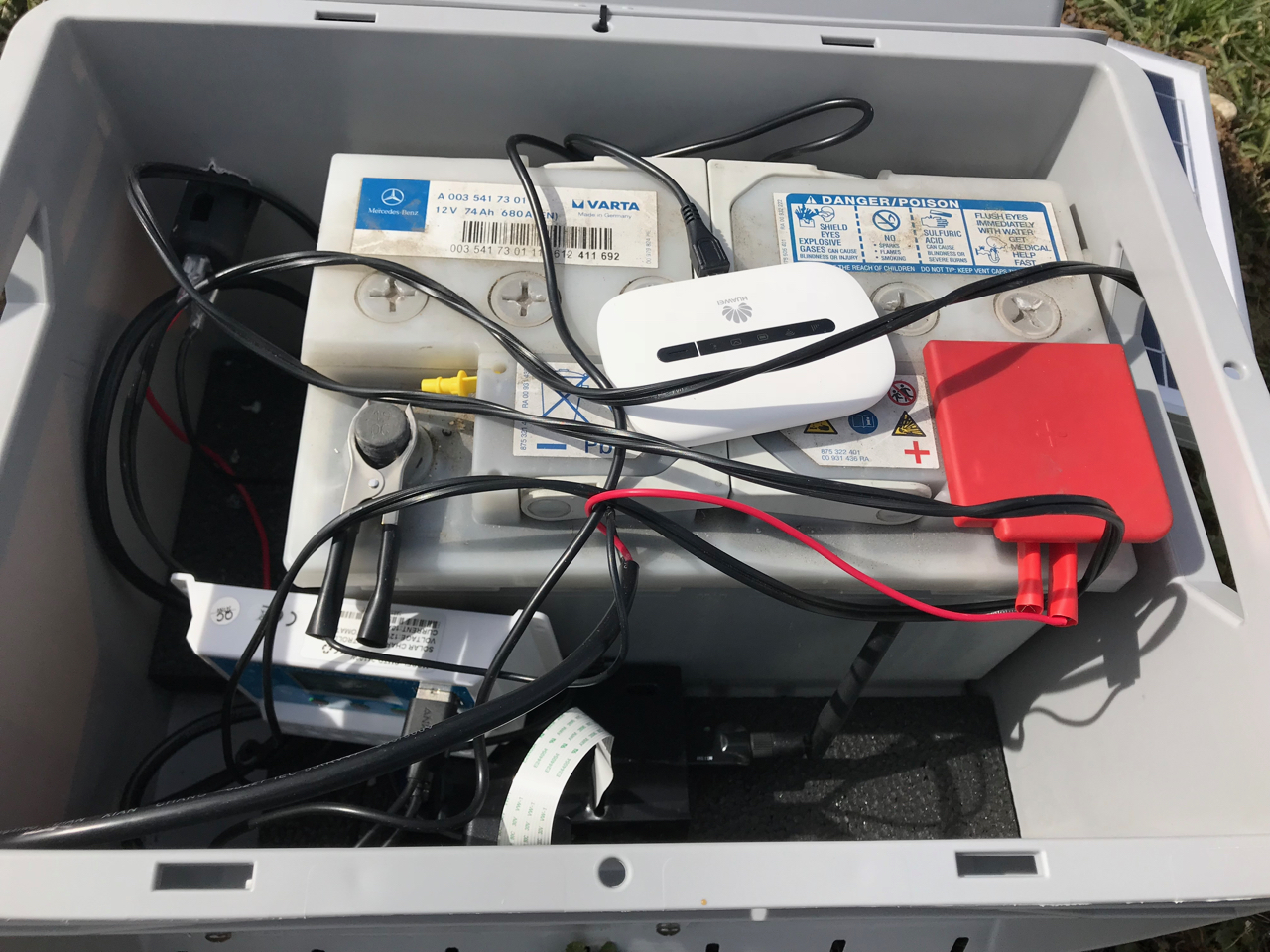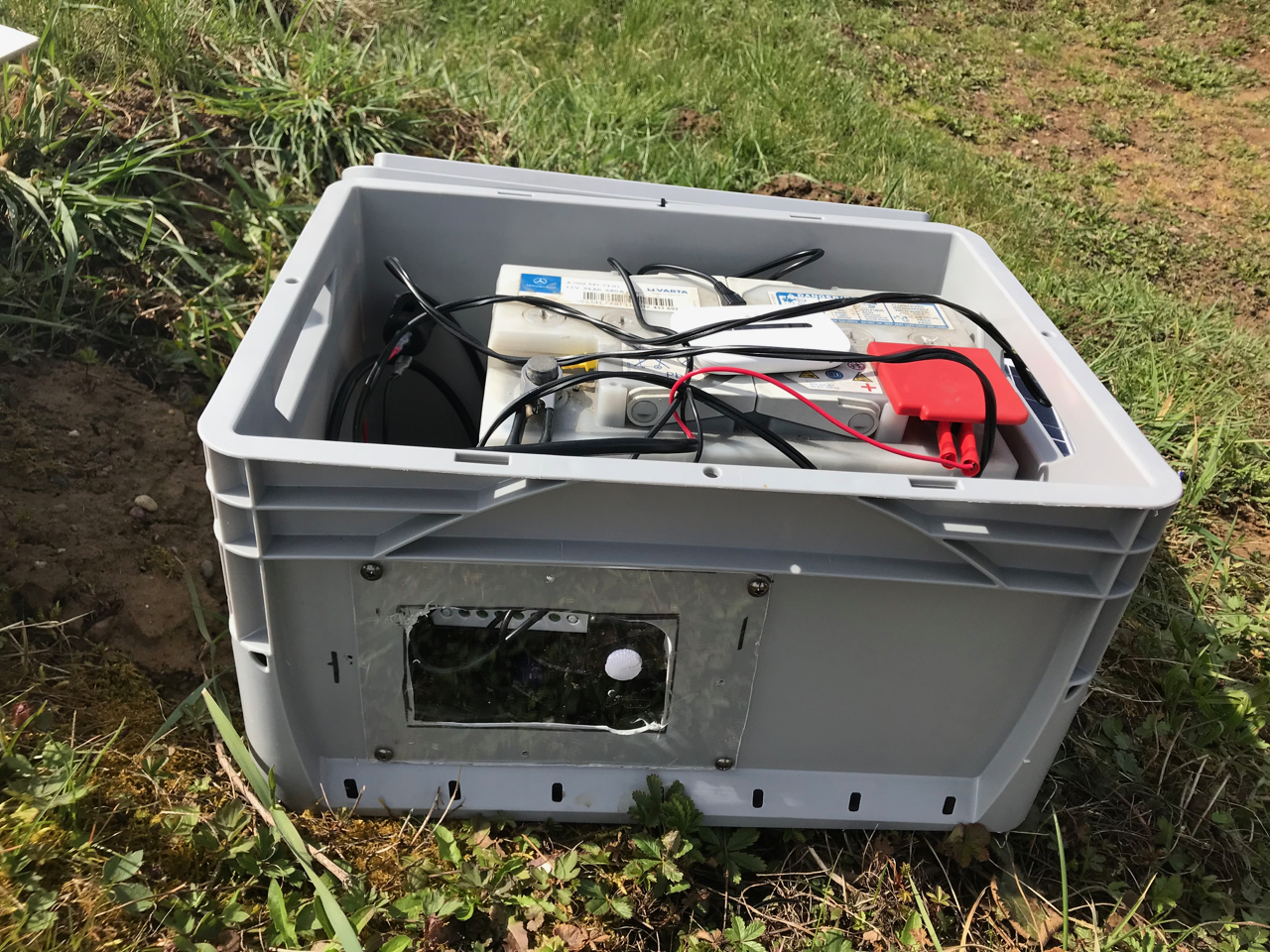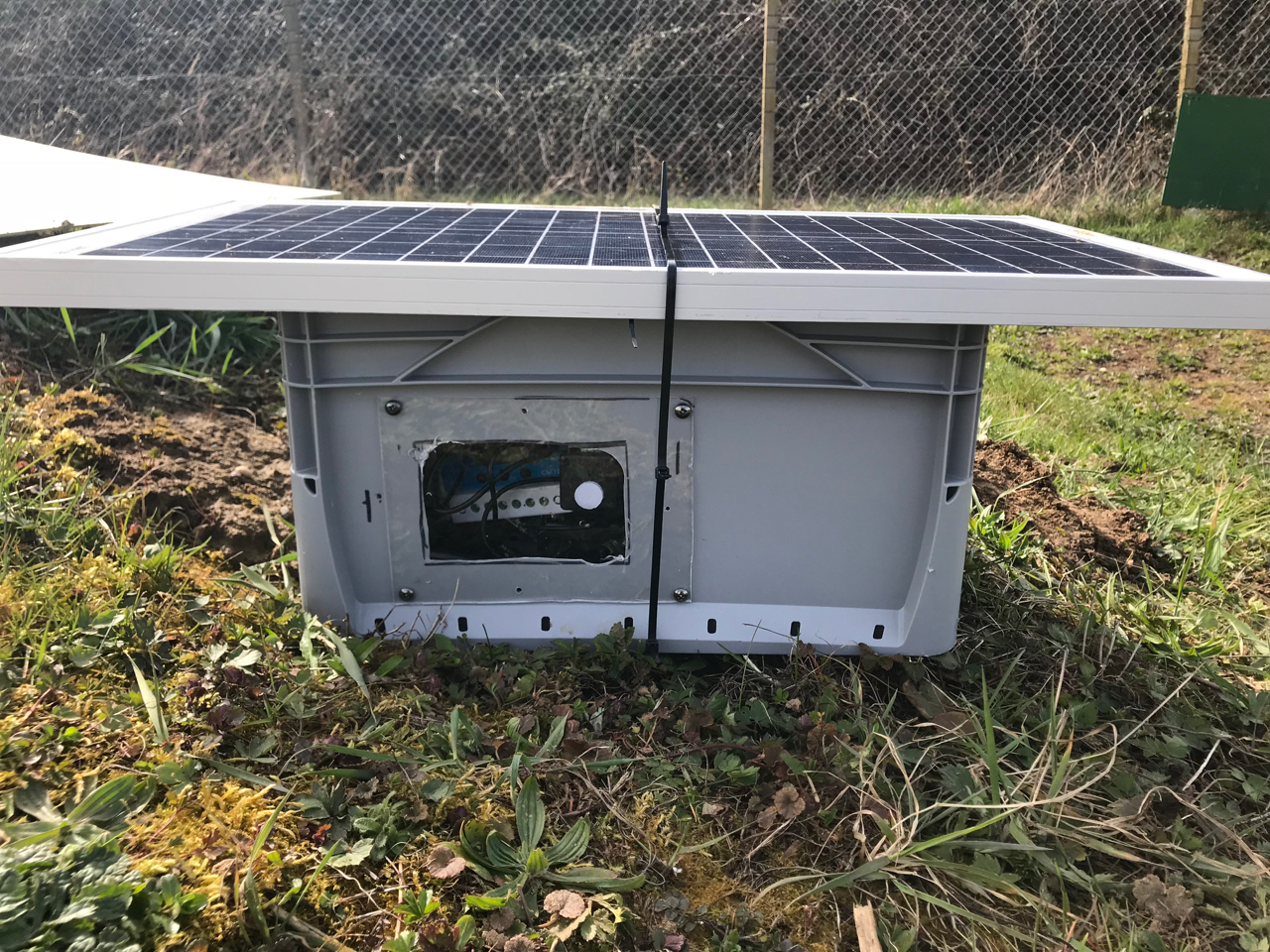Raspberry Pi WebCam with 3G (Solarcam)
Jump to navigation
Jump to search
The Idea
- Use solar panel to harvest energy
- Store the energy in a left over car battery
- Power a Pi, camera and
3G-StickMobile HotSpot[1] - Make a nice webcam out of it :)
Shopping List
- A Pi with camera :)
- A mobile Hotspot (I used a Huawei E1750C). Because getting an UMTS-Stick getting to work with an Pi sucks. Additionally you can easily join the WiFi network for maintenance)
- SIM Card
- (used) Car battery, in my case an 74Ah battery with one dead cell
- Solar panel (12V, 30W eBay around 40€) NOTE: Might be to small!
- Solar charger (f.e. "10A 12V/24V PWM solar panel regler solarpanel" @ ebay for around 15€)
- more to come…
How To
Update your Pi to the latest Linux version
See https://www.datenreise.de/raspberry-pi-raspbian-linux-wheezy-jessie-upgrade/
Scripts
Scripts running on the Pi
cronjobs
Add this to crontab:
# DS18B20 */15 * * * * /home/pi/Development/temperature/readTemperature.sh > /dev/null 2>&1 # # PiCam - Take Snapshot(s) */15 * * * * /home/pi/Development/webcam/takePicture.sh > /dev/null 2>&1
knock.sh
#!/bin/bash # knock on -heavens- servers door...(bad joke. sorry) for x in 2323 4242 5555; do nmap -Pn --host_timeout 201 --max-retries 0 -p $x my_fqdn; done
(needs knockd)
takePicture.sh
#!/bin/bash #set -x # # http://www.wurst-wasser.net/wiki/index.php/Raspberry_Pi_WebCam_with_3G # # Globals # GFOLDERTARGET="/var/www/html/webcam-archive" GFILELOCK="${GFOLDERTARGET}/takePicture.lck" GFILELOCKAGEMAX="60" GTIMESTAMP="`date +'%Y-%m-%d_%H-%M-%S'`" GTIMESTAMPDATE="`date +'%Y-%m-%d'`" # Human readable GTIMESTAMPTIME="`date +'%H:%M:%S'`" # Human readable GTIMESTAMPMINUTES="`date +'%M'`" GTIMESTAMPHOURS="`date +'%H'`" #GTIMESTAMPHOURS="16" #GTIMESTAMPMINUTES="00" GFILETARGET="${GFOLDERTARGET}/${GTIMESTAMP}.jpg" GFILELASTSNAP="/var/www/html/webcam/lastsnap.jpg" GUPLOADEVERYTIME=0 GBASENAME="${0}" function log { logger "${GBASENAME}: $1" echo $1 } if [ "${1}" = "-f" ]; then log "Forcing upload." GUPLOADEVERYTIME=1 fi # # # # Main # # # Check locking if [ -f "${GFILELOCK}" ]; then LOCKFILEAGE="`stat --format=\"%Z\" \"${GFILELOCK}\"`" NOW="`date +'%s'`" AGE="`expr ${NOW} - ${LOCKFILEAGE}`" if [ "${AGE}" -gt "${GFILELOCKAGEMAX}" ]; then log "Lockfile is ${AGE} seconds old, removing it." rm "${GFILELOCK}" else log "Lockfile is ${AGE} seconds old, exiting." exit 1 fi fi # # # Lock echo $$ > "${GFILELOCK}" # # timeout should not be 0, since images will be to dark and are noisy #raspistill --nopreview -t 1 -w 1024 -h 768 -o - # # Since my cam is mounted wrong, I prefer to flip it :) (and flop it) #raspistill --nopreview -t 2 -w 1024 -h 768 -o - | convert - -flip -flop - #raspistill --nopreview -w 1024 -h 768 -o - | convert - -flip -flop - raspistill --nopreview -w 1024 -h 768 -o - | convert - -flip -flop - > "${GFOLDERTARGET}/lastsnap.tmp" # # Bild verkleinern... mogrify -quality "80%" -interlace Plane "${GFOLDERTARGET}/lastsnap.tmp" #mogrify -stroke white -pointsize 10 -gravity SouthEast -draw "text 0,0 '${GTIMESTAMPHR}'" "${GFOLDERTARGET}/lastsnap.tmp" #mogrify -stroke white -pointsize 10 -gravity SouthWest -draw "text 0,0 '${GTIMESTAMPDATE}'" "${GFOLDERTARGET}/lastsnap.tmp" #mogrify -stroke white -pointsize 10 -gravity SouthEast -draw "text 0,0 '${GTIMESTAMPTIME}'" "${GFOLDERTARGET}/lastsnap.tmp" mogrify -stroke black -pointsize 10 -gravity NorthWest -draw "text 0,0 '${GTIMESTAMPDATE}'" "${GFOLDERTARGET}/lastsnap.tmp" mogrify -stroke black -pointsize 10 -gravity NorthEast -draw "text 0,0 '${GTIMESTAMPTIME}'" "${GFOLDERTARGET}/lastsnap.tmp" # # Save the taken picture to the archive, give the file a nice timestamped name mv "${GFOLDERTARGET}/lastsnap.tmp" "${GFILETARGET}" # # Copy the latest image to the "current view" - folder cp "${GFILETARGET}" "${GFILELASTSNAP}" # #raspistill -t 0 -w 1024 -h 768 -o - # # Make a upload to our webserver if [ "${GTIMESTAMPHOURS}" -ge 0 -a "${GTIMESTAMPHOURS}" -le 23 -o "${GUPLOADEVERYTIME}" -eq 1 ]; then # Between 0 and 0 o'clock if [ "${GTIMESTAMPMINUTES}" -eq 0 -o "${GTIMESTAMPMINUTES}" -eq 15 -o "${GTIMESTAMPMINUTES}" -eq 30 -o "${GTIMESTAMPMINUTES}" -eq 45 -o "${GUPLOADEVERYTIME}" -eq 1 ]; then log "Uploading picture..." ~/Development/webcam/knock.sh # scp "${GFILETARGET}" dt:tmp/ sftp dt:tmp/ <<< "put ${GFILETARGET}" fi fi # # Cleanup: Delete all files older than n*24 hours find "${GFOLDERTARGET}" -ctime +1 -delete # # Unlock rm "${GFILELOCK}" # # Exit exit 0
readTemperature.sh
#!/bin/bash
#set -x
#
# Script: readTemperature.sh
# Author: Heiko Kretschmer
# Purpose: Reading the temperature and generating a nice plot
#
#
#
# Globals
#
GDEVICEID="10-000802ae4298"
#GDEVICEID="10-000802ad5087"
GDEVICESPATH="/sys/bus/w1/devices"
GDEVICEVALUEFILE="w1_slave"
GTIMESTAMPFORMAT="%Y-%m-%d_%H:%M"
GTIMESTAMP="`date +${GTIMESTAMPFORMAT}`"
GTIMESTAMPTIME="`date '+%H:%M'`"
GTIMESTAMPDATE="`date '+%Y-%m-%d'`" # ISO 8601 date format
GTIMESTAMPDATEHUMANREADABLE="`date '+%A, %Y-%m-%d'`"
GFOLDERBASE="/home/pi/Development/temperature"
GFOLDERLOGS="${GFOLDERBASE}/logs"
GFOLDERGRAPHS="${GFOLDERBASE}/graphs"
GFOLDERTMP="${GFOLDERBASE}/tmp"
GFILELOG="${GFOLDERLOGS}/readTemperature_${GTIMESTAMPDATE}.log"
GFILEGRAPH="${GFOLDERGRAPHS}/readTemperature_${GTIMESTAMPDATE}.svg"
GFILEPLOTCOMMANDS="${GFOLDERTMP}/readTemperature-plot.cmd"
GTIMESTAMPMINUTES="`date +'%M'`"
GTIMESTAMPHOURS="`date +'%H'`"
GUPLOADEVERYTIME=0
GBASENAME="${0}"
function log
{
logger "${GBASENAME}: $1"
echo $1
}
if [ "${1}" = "-f" ]; then
log "Forcing upload."
GUPLOADEVERYTIME=1
fi
#
# Main
#
# Init
test ! -d "${GFOLDERLOGS}" && mkdir "${GFOLDERLOGS}"
test ! -d "${GFOLDERGRAPHS}" && mkdir "${GFOLDERGRAPHS}"
test ! -d "${GFOLDERTMP}" && mkdir "${GFOLDERTMP}"
# Get the temperature
VALUERAW="`cat \"${GDEVICESPATH}/${GDEVICEID}/${GDEVICEVALUEFILE}\" | grep t= | cut -d= -f2`"
VALUE="`echo \"scale = 3; ${VALUERAW} / 1000\" | bc`"
#echo Temperature: ${VALUE}
# Write it into the log (one logfile per day to get nice graphs)
echo -e "${GTIMESTAMPTIME}\t${VALUE}" >> "${GFILELOG}"
# Generate the graph
test -f "${GFILEPLOTCOMMANDS}" && rm "${GFILEPLOTCOMMANDS}"
echo "reset" >> "${GFILEPLOTCOMMANDS}"
echo "set key inside right top vertical Right noreverse enhanced autotitles columnhead nobox" >> "${GFILEPLOTCOMMANDS}"
# Set time format for X axis
echo "set timefmt \"%H:%M\"" >> "${GFILEPLOTCOMMANDS}"
echo "set xdata time" >> "${GFILEPLOTCOMMANDS}"
echo "set format x \"%H:%M\"" >> "${GFILEPLOTCOMMANDS}"
# Setup line style (#1) for the temperature line
echo "set style line 1 lc rgb '#8b1a0e' pt 1 ps 1 lt 1 lw 2" >> "${GFILEPLOTCOMMANDS}" # http://www.gnuplotting.org/tag/grid/
echo "set style data lines" >> "${GFILEPLOTCOMMANDS}"
# Set X tics (one tic per hour, rotate that tick-labels by 90 deg and move em a bit)
echo "set xtics \"01:00\" rotate by 90 offset 0,-2 out nomirror" >> "${GFILEPLOTCOMMANDS}"
# Setup Grid (with line style #12)
echo "set style line 12 lc rgb '#E0E0E0' lt 0 lw 1" >> "${GFILEPLOTCOMMANDS}" # http://www.gnuplotting.org/tag/grid/
echo "set grid back ls 12" >> "${GFILEPLOTCOMMANDS}" # http://www.gnuplotting.org/tag/grid/
# Setup Title
echo "set title \"Temperature on ${GTIMESTAMPDATEHUMANREADABLE}\"" >> "${GFILEPLOTCOMMANDS}"
# Label X and Y Axis
echo "set ylabel \"°C\"" >> "${GFILEPLOTCOMMANDS}"
echo "set xlabel \"Time\" offset 0,-0.5" >> "${GFILEPLOTCOMMANDS}"
# Setup Y range
echo "set yrange [ 0.000 : ] noreverse nowriteback" >> "${GFILEPLOTCOMMANDS}"
# Set output file type to svg and plot it into file
echo "set term svg size 640,480" >> "${GFILEPLOTCOMMANDS}"
echo "set output \"${GFILEGRAPH}\"" >> "${GFILEPLOTCOMMANDS}"
echo "plot \"${GFILELOG}\" using 1:2 title 'Temperature' with l ls 1" >> "${GFILEPLOTCOMMANDS}"
cat "${GFILEPLOTCOMMANDS}" | gnuplot
# Copy this to Webserver
if [ "${GTIMESTAMPMINUTES}" -eq 0 -o "${GTIMESTAMPMINUTES}" -eq 30 -o "${GUPLOADEVERYTIME}" -eq 1 ]; then
log "Uploading hourly graph..."
# scp "${GFILEGRAPH}" dt:tmp/
~/Development/webcam/knock.sh
sftp dt:tmp/ <<< "put ${GFILEGRAPH}"
rm "${GFILEGRAPH}"
fi
#
# EOF
Scripts running on the web server
cronjobs
# m h dom mon dow command 02,17,32,47 * * * * ~/bin/movePictures.sh >> /dev/null 2>&1 # # Create a daily time-lapse 50 23 * * * ~/bin/mergeAllPicturesInOneAnimatedGIF.sh >> /dev/null 2>&1
movePictures.sh
(called by crond)
#!/bin/bash
#set -x
# movePictures.sh
# Author: Heiko
# Purpose: Move files into place (Webserver), set lastsnap and delete old files...
# Globals
GFOLDERWWW="/var/www/html/solarcam"
GFOLDERWWWIMAGES="${GFOLDERWWW}/webcam-archive"
GFILEWWWLASTSNAP="${GFOLDERWWW}/webcam/lastsnap.jpg"
GFILEWWWLASTGRAPH="${GFOLDERWWW}/webcam/lastgraph.svg"
GHOME="/home/solarcam"
# Move the image in place
mv "${GHOME}/tmp/"*.jpg "${GFOLDERWWWIMAGES}/"
mv "${GHOME}/tmp/"*.svg "${GFOLDERWWWIMAGES}/"
# Make the newest "lastsnap"
FILENEWEST="`ls -Art \"${GFOLDERWWWIMAGES}\" | grep jpg | tail -1`"
cp -p "${GFOLDERWWWIMAGES}/${FILENEWEST}" "${GFILEWWWLASTSNAP}"
FILENEWEST="`ls -Art \"${GFOLDERWWWIMAGES}\" | grep svg | tail -1`"
cp -p "${GFOLDERWWWIMAGES}/${FILENEWEST}" "${GFILEWWWLASTGRAPH}"
# Cleanup: Delete all files older than n*24hrs
find "${GFOLDERWWWIMAGES}" -ctime +30 -delete
# EOF
mergeAllPicturesInOneAnimatedGIF.sh
(called by crond)
#!/bin/bash
set -x
#
# Script: mergeAllPicturesInOneAnimatedGIF.sh
# Author: Heiko Kretschmer
# Purpose: Merge all .jpg into one animated .gif
#
# History:
# 2014-03-30, 09:52, h: Creation. Note. default ticks in -delay is n/100 of a second
# 2018-03-31, 08:11, h: Moved to dt. Make daily GIF.
#
# Globals
#
GFOLDERSOURCE="/var/www/html/solarcam/webcam-archive"
GSUFFIXSOURCE="jpg"
GTIMESTAMP="`date +'%Y-%m-%d'`"
#GTIMESTAMP="2018-03-29"
#echo "${GTIMESTAMP}"
#exit 0
GFILETARGET="/var/www/html/solarcam/webcam-archive/${GTIMESTAMP}.gif"
# (Un)Main
#
convert -limit area 0 -delay 25 -loop 1 "${GFOLDERSOURCE}/${GTIMESTAMP}*.${GSUFFIXSOURCE}" "${GFILETARGET}"
index.php
(place in your web server directory)
<?php
?>
<!doctype html public "-//W3C//DTD HTML 4.0 //EN">
<html>
<head>
<title>Webcam History</title>
<META HTTP-EQUIV="refresh" CONTENT="3600">
</head>
<body style="background-color:#EEEEEE">
<H1>Webcam Live Image</H1>
<img src="./webcam/lastsnap.jpg" />
<img src="./webcam/lastgraph.svg" />
<H1>Webcam History</H1>
<?php
$imagepath = "./webcam-archive";
$images = scandir($imagepath);
$images = array_reverse($images); // newest on top
foreach($images as $curimg)
{
if (substr($curimg, 0, 1)!="." && filesize("$imagepath/$curimg")>10000 &&
( strstr($curimg, ".swf") || strstr($curimg, ".avi") || strstr($curimg, ".mpg") || strstr($curimg, ".jpg") || strstr($curimg, ".gif") ) )
{
/* Link to Viewing-Page */
$curimgencoded=urlencode($curimg);
echo "<a href='./imageviewer.php?filename=$curimgencoded' alt='Show $curimg' />$curimg<br>\n";
/* Direct Link to Image File */
if (0)
{
#echo "<H2>$curimg</H2>\n";
#echo "<img src='$imagepath/$curimg' alt='$curimg' /><br>$curimg<br>\n";
echo "<a href='$imagepath/$curimg' alt='$curimg' />$curimg<br>\n";
#echo "<hr>\n";
}
}
};
?>
<hr>
<br/>
<a href='./index.php'>Back!</a>
</body>
</html>
imageviewer.php
(place in your web server directory)
<?php
?>
<!doctype html public "-//W3C//DTD HTML 4.0 //EN">
<html>
<head>
<title>Webcam History</title>
<META HTTP-EQUIV="refresh" CONTENT="60">
</head>
<body style="background-color:#EEEEEE">
<?php
/* Chosen Image */
$filename=htmlspecialchars($_GET["filename"]);
echo("<H1>Webcam Archive Image: $filename</H1>\n");
//echo("<H2>Showing " . $filename . "</H2><br/>\n");
$imagepath = "./webcam-archive";
/* Alle Bilder im Archiv finden (Non-Bilder wegfiltern) */
$images = scandir($imagepath); // Alle Bilder im Ordner
#echo("images:\n");
#print_r($images);
#echo("---\n");
$imagesfiltered=array();
foreach($images as $curimg) // filter alles weg, was kein Bild ist!
{
#echo("Checking: $curimg<br/>\n");
if (substr($curimg, 0, 1)!="." && filesize("$imagepath/$curimg")>10000 &&
( strstr($curimg, ".swf") || strstr($curimg, ".avi") || strstr($curimg, ".mpg") || strstr($curimg, ".jpg") ) )
{
array_push($imagesfiltered, $curimg);
}
}
#echo("imagesfiltered:\n");
#print_r($imagesfiltered);
#echo("---\n");
/* Finde das vorherige und das nachfolgende Bild */
$idx=array_search($filename, $imagesfiltered);
#echo("idx: $idx<br/>\n");
/* Previous Image-Link erzeugen */
$previouslink="";
if ($idx>0)
{
$previousimage=$imagesfiltered[$idx-1];
$previousimageencoded=urlencode($previousimage);
$previouslink="<a href='./imageviewer.php?filename=$previousimageencoded' alt='Show previous image'>< Previous Image <</a>\n";
}
/* Next Image-Link erzeugen */
$nextlink="";
if ($idx<count($imagesfiltered)-1)
{
$nextimage=$imagesfiltered[$idx+1];
$nextimageencoded=urlencode($nextimage);
$nextlink="<a href='./imageviewer.php?filename=$nextimageencoded' alt='Show next image'>> Next Image ></a>\n";
}
/* Obere Navigation */
echo("<p align='center'>\n");
//echo("$previouslink");
//if (strlen($previouslink) > 1) { echo($previouslink); }
if (strlen($previouslink) > 1 ) { echo($previouslink); }
echo(" "); // http://de.wikihow.com/Leerzeichen-in-HTML-einfügen
if (strlen($nextlink) > 1) { echo($nextlink); }
echo("</p>\n");
/* Das Bild */
echo("<p align='center'>\n");
echo("<img src='" . $imagepath . "/" . $filename . "' alt='$filename' />\n");
echo("</p>\n");
/* Untere Navigation */
echo("<p align='center'>\n");
if (strlen($previouslink) > 1 ) { echo($previouslink); }
echo(" "); // http://de.wikihow.com/Leerzeichen-in-HTML-einfügen
if (strlen($nextlink) > 1) { echo($nextlink); }
echo("</p>\n");
if (0)
foreach($images as $curimg)
{
if (substr($curimg, 0, 1)!="." && filesize("$imagepath/$curimg")>10000 &&
( strstr($curimg, ".swf") || strstr($curimg, ".avi") || strstr($curimg, ".mpg") || strstr($curimg, ".jpg") ) )
{
#echo "<H2>$curimg</H2>\n";
#echo "<img src='$imagepath/$curimg' alt='$curimg' /><br>$curimg<br>\n";
echo "<a href='$imagepath/$curimg' alt='$curimg' />$curimg<br>\n";
#echo "<hr>\n";
}
};
?>
<hr>
<br/>
<a href='./index.php'>Back!</a>
</body>
</html>
Photos
The finished product looks like this:



Tips
- Remember that this Pi is in the wild and easily stolen or all the data read
- Don't use your usual passwords for this project
- Don't store keys on the Pi
- Let your master server fetch the data (so no private keys are stored on the Pi) or use a chroot environment
- Create a special user to access the data from remote, or even better, get it per HTTP and use .htaccess for privacy (and less 3G-traffic ;) )
- If your WiFi connection breaks regularly, see Raspberry Pi WiFi issue (Solarcam)
?
- Links
- Raspberry Pi WiFi issue (Solarcam)
- https://www.datenreise.de/raspberry-pi-raspbian-linux-wheezy-jessie-upgrade/
- http://zieren.de/raspberry-pi/huawei-e303-3g-stick/
- http://garethhowell.com/wp/connect-raspberry-pi-3g-network/
- My buddy's solar webcam project: http://buchkopfturm.solar-webcam.de/ which is documented here: https://www.foto-webcam.eu/wiki/
- ↑ Since setting up the 3G-Stick was a pain in...